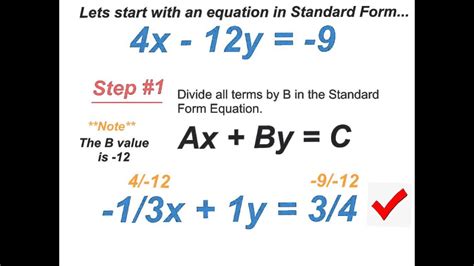Converting standard form to slope-intercept form is a crucial skill in algebra and geometry. It allows us to rewrite linear equations in a more intuitive and useful way, making it easier to graph lines, find slopes, and identify y-intercepts. In this article, we will explore the steps to convert standard form to slope-intercept form easily, along with practical examples and explanations.
Understanding Standard Form and Slope-Intercept Form

Before we dive into the conversion process, let's quickly review the two forms.
Standard form, also known as general form, is a way of writing linear equations in the form:
Ax + By = C
where A, B, and C are constants, and x and y are the variables.
Slope-intercept form, on the other hand, is a way of writing linear equations in the form:
y = mx + b
where m is the slope of the line, and b is the y-intercept.
Why Convert Standard Form to Slope-Intercept Form?
Converting standard form to slope-intercept form has several advantages:
- It makes it easier to identify the slope and y-intercept of the line.
- It allows us to graph lines more easily using the slope and y-intercept.
- It facilitates the calculation of linear equations and inequalities.
The Conversion Process

To convert standard form to slope-intercept form, follow these steps:
- Rearrange the equation to isolate y: Move the constant term to the right-hand side, and rearrange the terms to isolate y.
- Divide both sides by the coefficient of y: If the coefficient of y is not 1, divide both sides of the equation by that coefficient to make it 1.
- Simplify the equation: Combine like terms and simplify the equation to get it in slope-intercept form.
Let's work through some examples to illustrate the conversion process.
Example 1: Converting Standard Form to Slope-Intercept Form
Convert the equation 2x + 3y = 5 to slope-intercept form.
Solution:
- Rearrange the equation to isolate y: 3y = -2x + 5
- Divide both sides by the coefficient of y: y = (-2/3)x + 5/3
- Simplify the equation: y = (-2/3)x + 5/3
The slope-intercept form of the equation is y = (-2/3)x + 5/3.
Example 2: Converting Standard Form to Slope-Intercept Form
Convert the equation x - 2y = 3 to slope-intercept form.
Solution:
- Rearrange the equation to isolate y: -2y = -x + 3
- Divide both sides by the coefficient of y: y = (1/2)x - 3/2
- Simplify the equation: y = (1/2)x - 3/2
The slope-intercept form of the equation is y = (1/2)x - 3/2.
Practical Applications of Converting Standard Form to Slope-Intercept Form

Converting standard form to slope-intercept form has numerous practical applications in various fields, including:
- Graphing lines: By converting standard form to slope-intercept form, we can easily graph lines using the slope and y-intercept.
- Finding slopes: The slope-intercept form makes it easy to identify the slope of a line, which is essential in physics, engineering, and economics.
- Identifying y-intercepts: The slope-intercept form also makes it easy to identify the y-intercept of a line, which is crucial in graphing and analyzing functions.
Conclusion
Converting standard form to slope-intercept form is a simple yet powerful technique that can make a significant difference in your algebra and geometry studies. By following the steps outlined in this article, you can easily convert standard form to slope-intercept form and unlock a world of practical applications. Remember to practice, practice, practice, and you'll become a pro at converting standard form to slope-intercept form in no time!
What is the main difference between standard form and slope-intercept form?
+The main difference between standard form and slope-intercept form is the way the equation is written. Standard form is written in the form Ax + By = C, while slope-intercept form is written in the form y = mx + b.
Why is it important to convert standard form to slope-intercept form?
+Converting standard form to slope-intercept form makes it easier to identify the slope and y-intercept of the line, which is essential in graphing and analyzing functions.
How do I convert standard form to slope-intercept form?
+To convert standard form to slope-intercept form, follow these steps: Rearrange the equation to isolate y, divide both sides by the coefficient of y, and simplify the equation.
